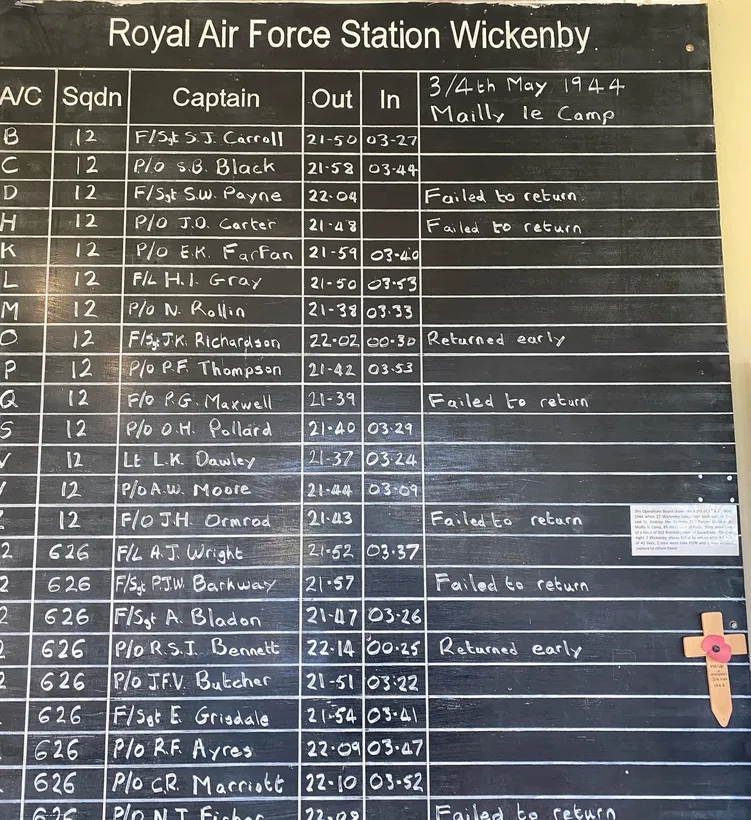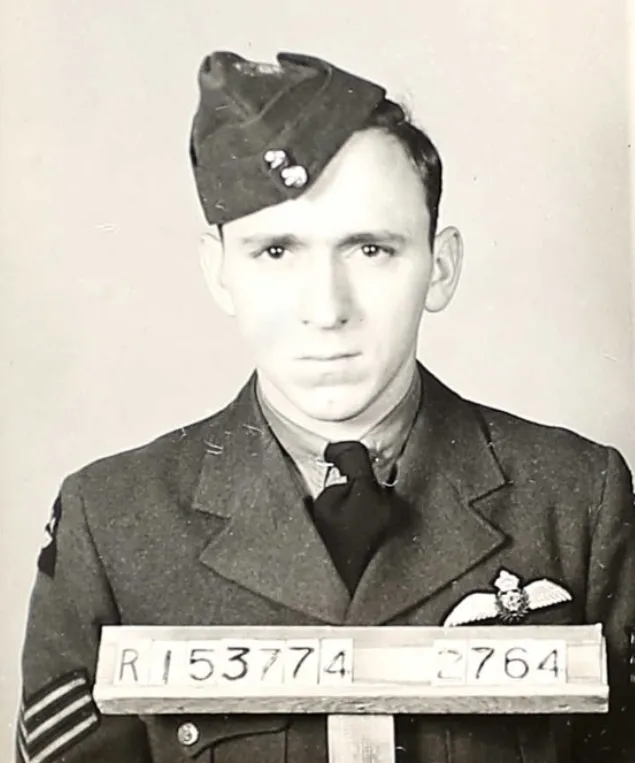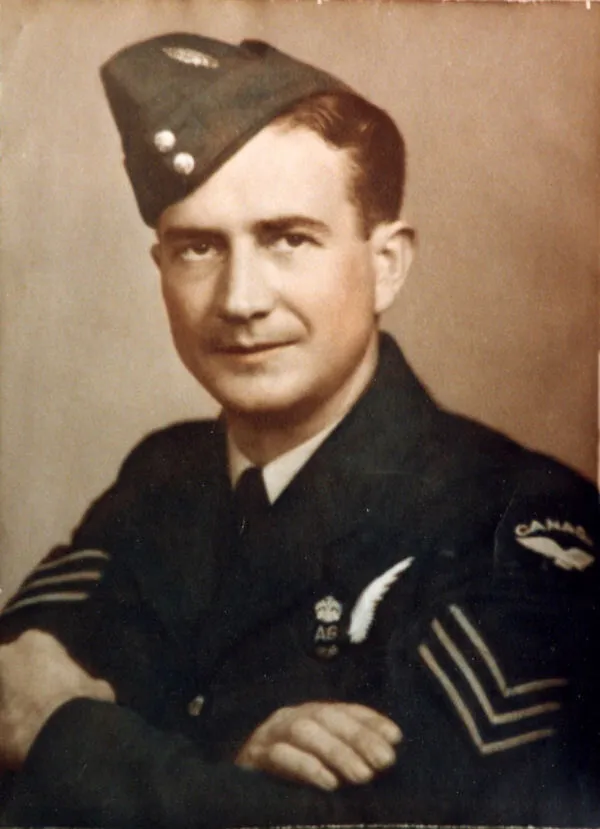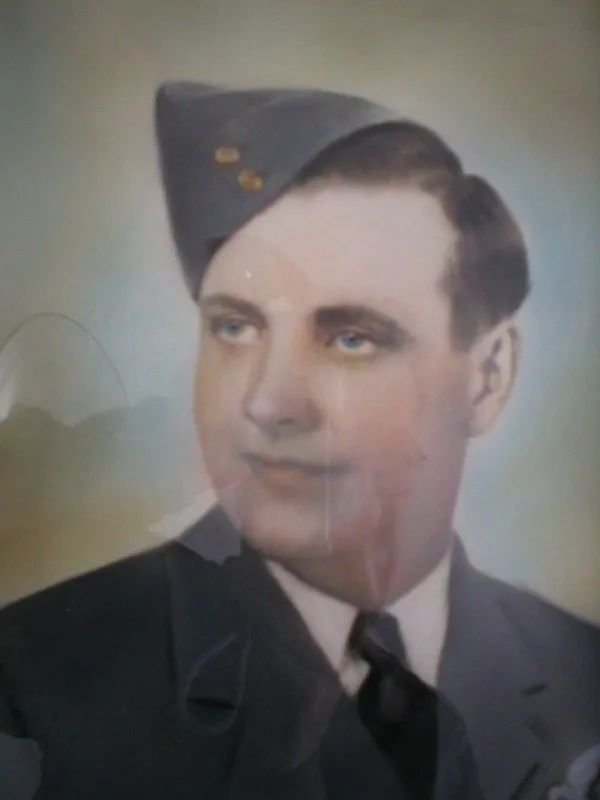
Barkway, Percy James William (Pilot Officer)
Killed in Action 1944-May-04


Birth Date: 1921-December-08
Born: England
Parents: Albert Percy and Mabel Annie Barkway (née Fisher)
Spouse: Jean Glen Barkway (née Morris) married Toronto 1943-03-16
Home: Toronto, Ontario
Enlistment:
Enlistment Date: unkown date
Service
RCAF
Unit
626 Sqn- Squadron (RAF)
To Strive And Not To Yield To strive and not to yeild
Base
RAF Wickenby
Rank
Pilot Officer
Position
Pilot
Service Numbers
J/86069
Prev: R/153744
Home
Target

Crew or Other Personnel
Lancaster DV281
Mission
Lancaster Mk.I/III DV281
Bombing Mailly-le-Camp France 1944-May-04 to 1944-May-04
626 (B) Sqn (RAF) Wickenby
On the night of Wednesday 3rd May 1944 Bomber Command operated a total of 600 sorties: 362 aircraft assigned to attack the Military Camp at Mailly-Le-Camp and 92 aircraft to attack the Luftwaffe Base at Montdidier, 146 aircraft were assigned to carry out Minor Operations: 34 O.T.U. sorties, 32 aircraft assigned to lay sea mines off the French coast and Frisian Islands 27 Aircraft to attack Ludwigshafen, 23 aircraft on Resistance operations, 14 aircraft to attack the ammunition dump at Châteaudun, seven aircraft on Intruder patrols, six aircraft on Serrate sorties, three aircraft on Radio Counter Measures. From these operations there were a total of 47 aircraft (7.83%): 44 Lancaster's a single Halifax, Lysander and Mosquito became non effective and struck off charge"¦ from these 47 aircraft there were a total of 322 casualties: 266 airmen died, 22 became Prisoners of War and 34 airmen evaded capture"¦ These airmen were from 24 Squadrons flying from 19 airfields from five Bomber Groups. The Committee of Adjustment would be clearing out many lockers, billets of personal material and the many telegrams would be being composed and sent to the many families around the world with family life being changed for some, for ever with many empty chairs"¦
Events to this raid on Mailly-le-Camp started in February 1944 when a French resistance man named Raymond Bassett whose code name was "˜Nazi' risked his life gathering information about the German occupied military camp at Mailly. Using a false police warrant card supplied by London he entered at great personal risk the main entrance of the Panzer Training and Maintenance camp. From his conversations with an attentive German Officer about the camp security, Raymond Bassett used his brilliant memory to recall information displayed on charts and plans scattered around the office. With his natural skill Raymond Bassett drew from memory plans and details about the camp and passed the information to another agent near Chalons-sur-Marne. A few weeks later at Bomber Command Headquarters at High Wycombe the Royal Air Force started preparing for an attack on this occupied military camp 128 kilometres east of Paris. By the spring of 1944 Bomber Command was getting more skilful in the art of directing the bomber stream towards obscure targets in enemy occupied territory with pinpoint accuracy. Also becoming more skilful in the accuracy of bombing with the emphasis drawn to the fact of nearby villages and towns such as Mailly. The operational order was issued to Numbers 1 & 5 Bomber Groups who were operating Lancaster bombers with 4 Mosquito's from No.617 Squadron and 10 Mosquito's from No.627 Squadron Light Night Striking Force who would all have the responsibility of marking this important target. The executive order for bomb loads was prefixed "˜Plumduff' calling for all mainstream Lancaster's to carry an instantaneously fused 4000lb "˜cookie' and sixteen 500lb GP (General purpose) fused from eleven seconds to six hours. This was intended to destroy completely the large Wehrmacht depot engaged in maintaining of armoured vehicles and tanks including the Panzer Training establishment. The Military camp also contained extensive workshops and over sixty large barrack blocks. The raid was carried out during a full moon period and the forecast for the night of Wednesday 3/4 May1944 was for fine weather with no cloud in the target area. No.617 Squadron lead by Wing Commander G.L. Cheshire DSO DFC was briefed to mark the target at midnight precisely. The main Lancaster force of 346 bombers lead by Wing Commander L.C. Deane DFC of No.83 Squadron would bomb the target in two waves, with No.5 Group Lancaster's leading the way. Only No.83 & No.97 Squadron's would carry H2S and only a few Squadrons would employ "˜window' whilst No.101 Squadron carrying Air Bourne Cigar (A.B.C.) jamming equipment. A new system of Pathfinding' was to be employed on this raid with four Mosquito's from No.617 Squadron marking the target with the backer up markers from No.627 Squadron Mosquito's. Wing Commander G.L. Cheshire would be the Master Bomber and would transmit using VHF. to Wing Commander L.C. Deane, leader of the main force who in turn would transmit to the main force. Backing up and moving the aiming point would be carried out by the Mosquito's who would remain in the target area so long as they had markers left. Take off for the attack commenced at 21.30 hours and continued for nearly 50 minutes from the Lincolnshire bases. The route to the target was uncomplicated, assemble west of Reading then south to Beachy Head, across the channel to make land fall a point 5 kilometres just NE of Dieppe. Then flying a straight course of 220 km to the target. Yellow route markers would be dropped 20 to 30 km N of the camp near the village of Germinon. These markers would act as a datum point for the final run up to the target, which would be attacked on a N to S heading. After the bombing run the attacking force would continue to the next turning point; over the town of Troyes, before heading west on a course south of Paris and eventually to the Normandy coast near Bayeux. Following a northerly track across the Channel to Selsey Bill and finally home to their respective basis. The leading illuminators from No's 83 & 97 Squadrons were dropped accurately at 5 minutes to midnight and the Yellow Datum Markers dropped by No.627 Squadron shortly after marking the way for the main force. Wing Commander Cheshire in his Mosquito dived from 3000 feet to just under 1500 feet before dropping his two Red target indicators. Not satisfied he called Wing Commander Deane and told him not to commence the attack. Cheshire summoned Squadron Leader D.J. Shannon to remark the target. Satisfied that the target was marked accurately Cheshire then instructed Deane to commence the attack, it was now six minutes past midnight. No.627 Squadron successfully backed up the datum point markers and then the leading main force Lancaster's were circling the target waiting for the instruction to bomb from the Master of Ceremonies'. As Deane attempted to order the main attack the radio frequency was almost totally jammed by an American ground station carrying out a training transmission on an unauthorised frequency. By this time more than sixty bombers had reached the yellow datum markers and were having to circle the target area awaiting instructions. As the wireless operator of Dearne's aircraft tried in vain to search for a common channel only fifteen bombers responded to the near indecipherable message. Despite the fact that No.100 Squadron was dropping "˜window' the German night fighters had penetrated the bomber stream, and in less than six minutes nine Lancaster's were tumbling out of the night sky in flames. During a short interval No.617 & No.627 aircraft remarked the target and a Lancaster of No.97 Squadron captained by Flying Officer H.J.W. Edwards laid ten red spot markers across the western edge of the target. The Deputy Bombing Leader Squadron Leader R.M. Sparks finally gave the order to commence bombing and in just over ten minutes over 250 Lancaster's dropped more than 1500 tons of explosives with great accuracy. There were six German night fighter bases within sixty kilometres of the main bomber force and that night two of the top German aces were operating Hauptman Drewes and Hauptman Bergmann. Between them they accounted for eleven of the 45 aircraft that was struck off charge that night. For the crews that operated and survived that night, the myth that targets in Occupied Countries were "˜a piece of cake' was completely destroyed. Although the raid was reviewed as a success it did not reflect the loss of 258 airmen killed on that clear moonlit night of Wednesday 3/4 May 1944.source: Buzz Hope "And in the Morning"
Lancaster serial: DV281

Canadian Warplane Heritage Museum
The Avro Lancaster is a British Second World War heavy bomber. It was designed and manufactured by Avro as a contemporary of the Handley Page Halifax, both bombers having been developed to the same specification, as well as the Short Stirling, all three aircraft being four-engined heavy bombers adopted by the Royal Air Force (RAF) during the same wartime era.
The Lancaster has its origins in the twin-engine Avro Manchester which had been developed during the late 1930s in response to the Air Ministry Specification P.13/36 for a capable medium bomber for "world-wide use". Originally developed as an evolution of the Manchester (which had proved troublesome in service and was retired in 1942), the Lancaster was designed by Roy Chadwick and powered by four Rolls-Royce Merlins and in one version, Bristol Hercules engines. It first saw service with RAF Bomber Command in 1942 and as the strategic bombing offensive over Europe gathered momentum, it was the main aircraft for the night-time bombing campaigns that followed. As increasing numbers of the type were produced, it became the principal heavy bomber used by the RAF, the Royal Canadian Air Force (RCAF) and squadrons from other Commonwealth and European countries serving within the RAF, overshadowing the Halifax and Stirling. Wikipedia

